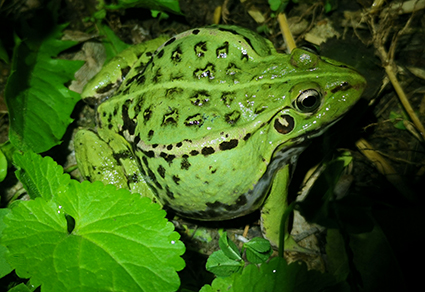Abstract
The Black-spotted Pond Frog, Pelophylax nigromaculatus, is widely distributed across mainland China, Korean Peninsula, and Japan. The taxonomic relationships among P. n. nigromaculatus, Rana nigromaculata mongolia (sensu P. n. mongolicus), and P. tenggerensis have long been ambiguous. Here we examine the topotype specimens of P. tenggerensis and R. n. mongolia, and provide phylogenic analyses based on four mitochondrial DNA sequences. The combined evidences from morphology and molecular phylogeny have shown the distinct specific-level of P. n. mongolicus that distant from P. nigromaculatus, while indicating the homogeneity between P. n. mongolicus and P. tenggerensis. Thus, we suggest elevating P. n. mongolicus as a full species Pelophylax mongolicus comb. nov., and place P. tenggerensis to be a secondary synonym of P. mongolicus comb. nov.
References
Amal, B., Bae, Y.H. & Groffen, J. (2017) Pelophylax chosenicus (Goldspotted Pond Frog). Herpetological Review, 48 (3), 79–80.
AmphibiaChina (2022) The database of Chinese amphibians. Kunming Institute of Zoology (CAS), Kunming, Yunnan. Available from: http://www.amphibiachina.org (accessed 10 February 2022)
AmphibiaWeb (2022) Information on amphibian biology and conservation. Berkeley, California, America. https://amphibiaweb.org/ (accessed 10 February 2022)
Dubois, A. & Ohler, A. (1994) Frogs of the subgenus Pelophylax (Amphibia, Anura, genus Rana): a catalogue of available and valid scientific names, with comments on the name-bearing types, complete synonymies. proposed common names, and maps showing all type localities. Zoologica Poloniae, 39 (3–4), 139–204.
Fei, L., Ye, C.Y. & Huang, Y.Z. (1990) A search for amphibians in China. Chongqing Branch of Scientific and Technical Literature Publishing House, Chongqing, 120 pp. [in Chinese]
Fei, L., Ye, C.Y., Huang, Y.Z., Jiang, J.P. & Xie, F. (2005) An illustrated key to Chinese amphibians. Sichuan Publishing House of Science and Technology, Chengdu, 340 pp. [in Chinese]
Fei, L., Hu, S.Q., Ye, C.Y. & Huang, Y.Z. (2009) Fauna Sinica—Amphibia. Vol. 2. Anura. Science Press, Beijing, pp. 1042–1071.
Frost, D.R., Grant, T., Faivovich, J., Bain, R.H., Haas, A., Haddad, C.F.B., De Sá, R.O., Channing,A., Wilkinson, M., Donnellan, S.C., Raxworthy, C.J., Campbell, J.A., Blotto, B.L., Moler, P.E., Drewes, R.C., Nussbaum, R.A., Lynch, J.D., Green, D.M. & Wheeler, W.C. (2006) The amphibian tree of life. Bulletin of the American Museum of Natural History, 297, 1–370. https://doi.org/10.1206/0003-0090(2006)297[0001:TATOL]2.0.CO;2
Frost, D.R. (2022) Amphibian Species of the World: an Online Reference. Version 6.1. Available from: https://amphibiansoftheworld.amnh.org/index.php (accessed 10 February 2022)
Lanfear, R., Calcott, B., Ho, S.Y. & Guindon, S. (2012) PartitionFinder: combined selection of partitioning schemes and substitution models for phylogenetic analyses. Molecular Biology and Evolution, 29, 1695–1701. https://doi.org/10.1093/molbev/mss020
Matsui, M., Ota, H., Lau, M.W. & Bogadek A. (1995) Cytotaxonomic studies of three ranid species (Amphibia: Anura) from HongKong. Japanese Jour Herpetology, 16 (1), 12–18. https://doi.org/10.5358/hsj1972.16.1_12
Lymberakis, P., Poulakakis, N., Manthalou, G., Tsigenopoulos, S., Magoulas, A. & Mylonas, M. (2007) Mitochondrial phylogeography of Rana (Pelophylax) populations in the Eastern Mediterranean region. Molecular Phylogenetics and Evolution, 44, 115–125. https://doi.org/10.1016/j.ympev.2007.03.009
Pyron, R.A. & Wiens, J.J. (2011) A large-scale phylogeny of Amphibia including over 2800 species, and a revised classification of advanced frogs, salamanders, and caecilians. Molecular Phylogenetics and Evolution, 61, 543–583. https://doi.org/10.1016/j.ympev.2011.06.012
Ronquist, F., Teslenko, M., Mark, P., Ayres, D.L., Darling, A., Höhna, S., Larget, B., Liu, L., Suchard, M.A. & Huelsenbeck, J.P. (2012) MrBayes 3.2: efficient Bayesian phylogenetic inference and model choice across a large model space. Systematic Biology, 61, 539–542. https://doi.org/10.1093/sysbio/sys029
Savage, J.M. (1975) Systematics and distribution of the Mexican and Central American stream frogs related to Eleutherodactylus rugulosus. Copeia, 2, 254−306. https://doi.org/10.2307/1442883
Schmidt, K.P. (1925) New Chinese amphibians and reptiles. American Museum Novitates, 175, 1–3.
Shannon, F.A. (1956) The reptiles and amphibians of Korea. Herpetologica, 12, 22–49.
Simon, C., Frati, F., Beckenbach, A., Crespi, B., Liu, H. & Flook, P. (1994) Evolution, weighting, and phylogenetic utility of mitochondrial gene sequences and a compilation of conserved polymerase chain reaction primers. Annals of the Entomological Society of America, 87, 651–701. https://doi.org/10.1093/aesa/87.6.651
Komaki, S., Lgawoa, T., Lin, S.M., Koji, T., Min, M.S. & Sumida, M. (2015) Robust molecular phylogeny and paleo distribution modelling resolve complex evolutionary history: glacialcycling drove recurrent mtDNA introgression among Pelophylax frogs in East Asia. Journal of Biogeography, 42, 2159–2171. https://doi.org/10.1111/jbi.12584
Tamura, K., Stecher, G., Peterson, D., Filipski, A. & Kumar, S. (2013) MEGA6: molecular evolutionary genetics analysis version 6.0. Molecular Biology and Evolution, 30, 2725–2729. https://doi.org/10.1093/molbev/mst197
Zhang, H., Yan, J., Zhang, G.Q. & Zhou, K.Y. (2008) Phylogeography and demographic history of Chinese black-spotted frog populations (Pelophylax nigromaculatus): evidence for independent refugia expansion and secondary contact. BMC Evolutionary Biology, 8 (21), 1–16. https://doi.org/10.1186/1471-2148-8-21
Zhang, D., Ma, S.M., Wei, B., Wang, C.C., Zhang, L. & Yan, H. (2022) Historical distribution pattern and driving mechanism of Haloxylon in China. Biodiversity Science, 30 (1), 1–10. [in Chinese] https://doi.org/10.17520/biods.2021192
Zhao, E.M., Macey, J.R. & Papenfuss, T.J. (1988) A new species of Rana from Ningxia Hui Autonomous Region. Asiatic Herpetological Research, 2, 1–3. https://doi.org/10.1093/aesa/87.6.651
Zhao, E.M., Macey J.R. & Papenfuss T.J. (1989) Original description of Rana tenggerensis. Sichuan Journal of Zoology, 8, 4. [in Chinese]
Zhao, Y. (2013) Comparative genealogical geography of Hyla tsinlingensis and Microhyla mixtura in Qinling mountains. Shaanxi Normal University, Shaanxi, 1–35. [in Chinese]
Zhou, S.B., Zhang, Z.H., Wang, H., Miao, Q., Xu, S.J., Guan, P. & Shi, J.S. (2022) New Record Species of Anura from China—Pelophylax chosenicus. Chinese Journal of Zoology, 57 (3) 440–446. [in Chinese] https://doi.org/10.13859/j.cjz.202203013


